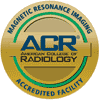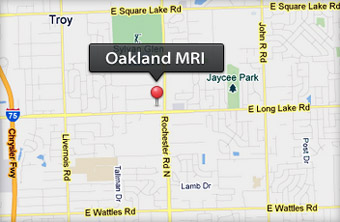Current diagnosis of Alzheimer disease (Alzheimer’s disease) is made by clinical, neuropsychological, and neuroimaging assessments. Routine structural neuroimaging evaluation is based on nonspecific features such as atrophy, which is a late feature in the progression of the disease. Therefore, developing new approaches for early and specific recognition of Alzheimer disease at the prodromal stages is of crucial importance.
Alzheimer disease was first described in 1907 by Alois Alzheimer. From its original status as a rare disease, Alzheimer disease has become one of the most common diseases in the aging population, ranking as the fourth most common cause of death. Alzheimer disease is a progressive neurodegenerative disorder characterized by the gradual onset of dementia. The pathologic hallmarks of the disease are beta-amyloid (Aß) plaques, neurofibrillary tangles (NFTs), and reactive gliosis. (See the images and slideshows below.)
Coronal, T1-weighted magnetic resonance imaging (MRI) scan in a patient with moderate Alzheimer disease. Brain image reveals hippocampal atrophy, especially on the right side. Axial, T2-weighted magnetic resonance imaging (MRI) scan of the brain reveals atrophic changes in the temporal lobes.
Effective therapies to cure Alzheimer disease, or to simply halt or slow its progression, are still lacking. A number of in vivo neuroimaging techniques that can be used to reliably and noninvasively assess aspects of neuroanatomy, chemistry, physiology, and pathology hold promise. With time and improvements in technology, these imaging techniques may yield acceptable neuroimaging biomarkers for Alzheimer disease.
Although present therapy for Alzheimer disease involves enhancers of cholinergic function, disease-modifying agents may be available in the future. Emphasis is being placed on detecting the presymptomatic phase of the disease, which can be termed mild cognitive impairment (MCI). Neuroimaging is also used to exclude other causes of dementia, such as normal-pressure hydrocephalus, brain tumors, subdural hematoma, and multiple infarctions.
Preferred examination
Magnetic resonance imaging (MRI) can be considered the preferred neuroimaging examination for Alzheimer disease because it allows for accurate measurement of the 3-dimensional (3D) volume of brain structures, especially the size of the hippocampus and related regions.
Neuroimaging is widely believed to be generally useful for excluding reversible causes of dementia syndrome, such as normal-pressure hydrocephalus, brain tumors, and subdural hematoma, and for excluding other likely causes of dementia, such as cerebrovascular disease.
The practice parameters for the diagnosis and evaluation of dementia, as published by the American Academy of Neurology (AAN), consider structural brain imaging optimal.[1] Nonenhanced computed tomography (CT) scanning and MRI are the appropriate imaging methods.[2] The AAN suggests that neuroimaging may be most useful in patients with dementia characterized by an early onset or an unusual course.
There have been several studies of neuroimaging findings in Alzheimer disease. Van de Pol et al found that medial temporal lobe atrophy seems to be a more important predictor of cognition than small-vessel disease in MCI. Lacunes were associated with performance on the Digit Symbol Substitution Test, especially in subjects with milder median temporal lobe atrophy (MTA). There was no discernible association between white matter hyperintensities (WMHs) and the cognitive measures in this study after adjustment for age.[3]
Study of the dopamine transporter (DaTScan) is used to distinguish Lewy body dementia from Alzheimer disease. Numerous studies are under way to identify specific imaging markers for different types of dementia, including cerebral volumetric measurements, diffusion imaging, spectroscopy, very-high-field MRI scans of senile plaques, and positron emission tomography (PET) scan markers of senile plaques.[4]
Blood-brain barrier (BBB) impairment is a stable characteristic over 1 year and is present in an important subgroup of patients with Alzheimer disease. Age, gender, ApoE status, vascular risk factors, and baseline Mini-Mental State Examination score did not explain the variability in BBB integrity. BBB impairment as a possible modifier of disease progression is suggested by correlations between the CSF-albumin index and measures of disease progression over 1 year.[5] The BBB is dysfunctional in a portion of all patients with Alzheimer disease, primarily in men. BBB dysfunction may influence the clearance of both harmful and beneficial substances across the barrier. Renal function may have an impact on the BBB.[6]
Pittsburgh Compound-B PET scan findings match histopathologic reports of Aß distribution in aging and dementia. Noninvasive longitudinal studies to better understand the role of amyloid deposition in the course of neurodegeneration and to determine if Aß deposition in nondemented subjects is preclinical Alzheimer disease are now feasible. Our findings also suggest that Aß may influence the development of dementia with Lewy bodies, and therefore, strategies to reduce Aß may benefit this condition.[7, 8, 9, 10]
De Leon et al concluded that the combined use of conventional imaging, such as MRI or fluorodeoxyglucose PET (FDG-PET) scanning, with selected CSF biomarkers can incrementally contribute to the early and specific diagnosis of Alzheimer disease. Moreover, selected combinations of imaging and CSF biomarker measures are of importance in monitoring the course of Alzheimer disease and, therefore, are relevant to evaluating clinical trials.[11]

